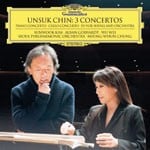3.3.3.3-4.4.3.2-perc(4):piano strings/t.bells/vib/bin-sasara/bamboo chime/2 Javanese gongs/guiro/SD (lg)/tamb(lg)/Japanese temple bell(lg)/BD/tam-t(lg)-harp-strings(12.12.10.10.8)
Abbreviations (PDF)
Boosey & Hawkes
Up to now, Unsuk Chin has largely avoided composing for instruments from traditional non-European musical cultures: the dangers of musical exoticism seemed too great to her. She changed her mind only after hearing the sheng virtuoso Wu Wei. A profilic musician, who feels equally home in many different musical styles, Wu Wei has contributed like no other to the popularization of the Chinese mouth organ outside of his native country. The premieres of some 130 contemporary works testify to his desire to expand the sheng's technical and expressive possibilities.
The sheng dates back over 3000 years, and is thus one of the oldest instruments based on the principle of the free reed (which found application in church organs and the accordion only in the eighteenth century). In recent times it has been radically modernized. The key mechanism has made possible chromaticism, polyphony, and a very wide ambitus that, in connection with the tonal versatility and the variability of its dynamics, contributes to the fascination of this instrument. Moreover, formidable skills are demanded of the sheng player, in as much as the sound is produced by alternately blowing and sucking in the air. In terms of timbre, finally, the sheng is a source of amazement with its various tonal facets, for example, when the sounds produced on it resemble those of electronic music.
Unsuk Chin relates that she first experienced the saenghwang (the sheng's Korean counterpart) as a child, when she heard someone playing it in the distance, on a mountain. This was unusual, since the mouth organ's role in Korean music is merely that of an accompaniment instrument. Ms. Chin associated this experience with the image of a "yearning for a distant sound,” which constitutes another motivation for the composition of Šu (Shu). The title derives from Egyptian mythology in which it represents a symbol for air. Indeed, as a result of the spatial aspect and the timbre, one often has the impression here of an open-air music, of sound that has become nature, albeit in a non-naturalistic manner.
The traditional idea of the concerto as a competition or contest yields to a game with constantly changing perspectives that takes advantage of camouflage, mimicry, and morphing. The instruments of the orchestra, which are employed as a group, in chamber–music-like formations, or even soloistically, act as the soloist’s shadow and echo, or form contrasts. At times they also blend with the sheng, to then run riot in striking passages and – like acoustic elemental forces – threaten to overwhelm the tonally powerful soloist. By means of exceptional playing techniques and unusual-subtle instrumentation, both the solo instrument as well as the symphonic apparatus are challenged anew. That which the latter traditionally suppresses, the sound verging on noise, becomes – in dialogue with “more normal” means of expression and ways of playing – a source of idiosyncratic beauty. Specific tone colors and, in particular, the treatment of the percussion group distantly resemble traditional Korean music. This is an example of how Unsuk Chin amalgamates the influences of traditional extra-European musical cultures and “Occidental” musical history (up to the avant-garde) in equal measure into her personal style.
Šu is based on a strict harmonic and formal plan: main notes, which form the harmonic foundation of this music, traverse a circle during the course of the piece, and in doing so are continually redefined in relation to one another. Other devices in the temporal organization are certain numerical proportions, whereby the number seven plays a significant role. The following pattern appears particularly often: a measure is subdivided into 4+3 units and mirrored by a measure with which it is coupled.
The one-movement work begins very simply: time and again, the sheng gently circles a tone that is encompassed by glistening, halo-like string harmonics. From these fragments, Chin “generates” broad, organic musical processes flowing in time, whereby various instrumental groups alternating with one another, melodic fragments, and motivic snippets are introduced. A continually recurring, percussion-dominated, rhythmically agitated motif, which is like an agglomeration of energy, attains particular importance. A percussion attack and a noisy interlude lead to an unexpected caesura, as if the preceding musical processes were revealed to be an illusion. However, this calculated chaos in turn “generates” organically developing processes. Out of wildly proliferating orchestral textures that ultimately collapse into themselves, a hurdy–gurdy-like, rhythmically four-square motif emerges in the sheng, which dominates a whole section in dialogue with spatially disposed harmonicas. A section exploring the borderlines between noise and sound and evoking spatial expanse and temporal paralysis follows. From these textures, an animated rhythmic pattern develops in the sheng, which, in four attempts, pushes higher and higher each time. This concept derives from Korean peasant or “Samulnori” music, whereby that what the composer makes of it has little if anything to do with the model. Two worlds collide in this quasi-cadenza, resulting in a high level of energy: the sheng plays a continuous, repetitive, strictly rhythmic figure that is commented upon by quasi-aleatoric orchestral patterns. Initially answered by rhythmical interjections from the membranophones and other percussion instruments, a great variety of flitting sounds, colors, and characters flash up during the sheng’s perpetuum mobile. After a short general pause, the stretto devolves increasingly into chaos and noise, to then ultimately lead into a rampant orchestral tutti that simultaneously introduces a kind of recapitulation. The tutti sound implodes; an alienated, fluctuating contrabass note emerges from the texture. The sheng takes up the motifs of the beginning, reflected by strings, which are located in the auditorium: the music returns in mutated form to its beginning and sinks into silence.´
© Maris Gothóni

Wu Wei/Seoul Philharmonic Orchestra/Myung-Whun Chung
Deutsche Grammophon 481 0971

